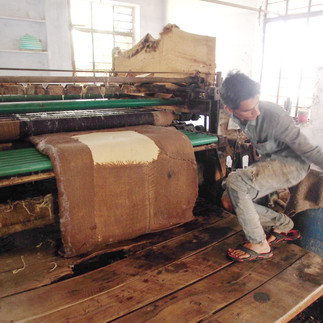We may think that felt-making is a ‘new’ craft when we look at the array of beautiful felt art, wearable nuno-felted clothing, felt sculptures - to name but a few art forms - yet wool felt has ‘been around’ for millenia.
Wool felt is one of the oldest forms of non-woven fabric – it is older than spinning and weaving and many cultures have legends about how of felt-making was invented.
It requires no bonding agent or complicated machinery - the fibres fuse together with a simple combination of moisture, heat, massaging and slight chemical action (weak acid or alkali). As there are no ‘threads’ it doesn’t fray when cut. Think then how useful it would have been to our ancestors - who had access to sheep but no looms - in the making of shelter, rugs and clothing.

Image showing a traditional method of making wool felt blankets by hand
There are many legends as to Felt's invention…
To prevent blisters, it is said that Roman Soldiers filled their uncomfortable boots with sheep fleece which they found attached to branches and twigs as they trudged through Wales. At the end of the day they would remove their boots to find felted wool socks, made from the fibres combining with sweat (providing heat and moisture) and being pounded during miles of marching.
Another story tells of Solomon’s son - a shepherd - who tried as he might to make wool fibres stick together. In a fit of temper he cried with frustration and stamped up and down on a fleece - when lo and behold he had discovered felt! Indeed, it could be possible that Jacob’s ‘coat of many colours’ was in fact felted from different coloured fleeces.
Other stories tell of felt being strong enough to compare with armour - able to withstand swords and fire. It is difficult to believe, as we strive to make ever finer felt that nomads have made tent coverings up to one inch thick. In Asia, even in the modern day, teams of men or women roll fibre bundles to make rugs. The process can take many hours and chants are sung to ensure a constant rhythm.
Fine felt rugs have been found in a Siberian Prince’s tomb - believed to be from a period at least 200 years BC - and these were in addition to felt used as decorations to blankets, masks, saddles and tent exteriors. Many different felt-making techniques were used including mosaic, inlay, appliqué and embroidery.
From about 400 B.C.E., felt was used so extensively in Central Asia that the area was known to the Chinese as "the land of felt." The goal of Genghis Khan was to unite "the people who live in felt tents," and by 1206 he ruled the second-largest empire in human history.
As in the past, felt still plays an integral part in the lives of Eurasian nomads, who live in lightweight felt tents – yurts - domed structures usually sixteen to twenty feet in diameter, made from a wooden framework covered with felt. Nomads also use felt for clothing, boots, hats, bags, carpets, blankets, horse paraphernalia, idols, and toys.
Modern Felt
The development of felting machines in the mid-1800s increased felt's uses - hats, slippers, the linings of silverware cases, carpet underlay, washers, gaskets, filters, polishing wheels, drum sticks, piano parts, felt pens and who remembers ‘fuzzy felt’ toys?!
Images portraying industrial felt making machinery
Nowadays, with the decline in traditional felt-making for consumables and the decrease in commercial production, there has been a revival in interest in the study of traditional felt and the production of handmade felt in arts and craft. There will always be interest in the magic of wet-felting and uses for wool felt.
Images portraying wearable felted art
Source - The art of the Felt Maker - ME Burkett
Images taken by Jane Evans in India and Wales











